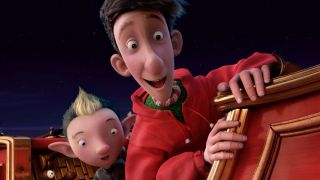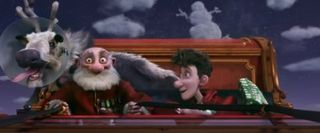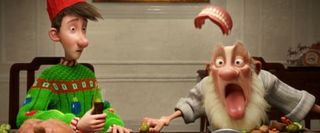Arthur Christmas Director On The Logic Of Santa And Her Idea For A Sequel

Arthur Christmas, as you might have heard by now, is one of the three truly terrific family-friendly movies opening this weekend-- between this one, The Muppets and Hugo, there's no excuse not to be going to the movies. And though Arthur Christmas comes from the same brilliant minds at Aardman Animation that created Wallace & Gromit, it's also the animation debut for its director, Sarah Smith, who was working as a writer and director in live-action television before she went to work in development at Aardman for what she thought would just be a six-month stint. Years later she's the director of Arthur Christmas, which she and Peter Baynham wrote together when they started wondering just how Santa Claus manages to deliver all those presents in a single night…
When I talked to Smith a few weeks ago, I asked her about how she and Baynham broke the story, how they managed to incorporate technology into a Christmas movie and "future-proof" it for evergreen viewings, what they might want to see in a sequel, how they were inspired by The Bourne Identity, and how she feels being one of the few women to direct an animated film. Check out the interview below and see Arthur Christmas in theaters this holiday weekend.
Last night Elf was on TV, as it is pretty much every half hour during the holidays, and it made me think about how hard it is to tell an original Christmas story. How hard was it for you to look at it and come up with an original story to tell about Santa Claus?
We didn't start from the point of view of going, "I know, let's do a Christmas movie, what will it be?" The best movies don't come from that, they come from a sideways inspiration. And Pete, my co-writer, had the idea of well, surely you can't really do this in a sleigh with that sack of presents, that doesn't work. What would it really take to get the job of Christmas done with all the children of the world in this day and age? Once you have that idea, you're off and making a Christmas story. Then the idea that it's an enormous operation, and the second part of his idea is that something goes wrong and Santa has a slightly idiot son who decides to make it right. And that was the nub of it. It's not that we decided to make a new take on Christmas, we just found ourselves in that world.
So you started from the idea of bringing modern technology to Santa.
Well we started saying what would it take to get it done. Really, that sleigh, of that size, an eight reindeer, you've got 650 million children… what would you need to get them all a present? We started working out logically what that operation would look like.
There are so many logic holes with the classic story of Santa. How do you muddle through all of that and have it not just be a movie of stating facts about how this works logically?
CINEMABLEND NEWSLETTER
Your Daily Blend of Entertainment News
You have to work it out in enormous detail, which I did to the most tragic degree. Even though you don't show your workings out, it has a totally credible sense because there is something very logical behind it all. Even if your audiences are only glimpsing the operation for 5 minutes, everything hangs together and you get the sense that there's a deep piece of working out behind it, which there was.
Did you have to keep it in the one zone of the planet because of the time zones?
The one bit of liberty we took for the story was we ignored time zones. We had the most hilariously heated three days where we decided that time zones could be great, because they would be flying in and out of darkness. Then I said to Pete, look, we want kids to enjoy this movie, we have a deadline, which is the sun is going to come up. You've got to keep it simple. You have to say this is a movie about Christmas Night and Christmas Night has to be the same for children all over the world. There aren't many 8-year-olds who are lying there thinking about time zones. OK, Christmas Night isn't a totally true, logical thing. Apart from that everything was worked out mathematically.

You came to Aardman as a head of development and then started work on Arthur Christmas which eventually became your project. How do you work out that transition from executive to director, especially when you're not an animator?
It's really tough, and I'm sure it must be very frustrating to lots of people in animation, that I had less skills than almost anyone on the film. At the same time, I come from a script and character and story background. And sometimes animators run into trouble for not having that piece of it. The team I worked with was very generous to me saying, "It's OK, you don't need to know how to do this, we know how to do this. We need the piece that you can give us."
When you're tackling the story, do you write and throw away over and over again? is it a lot of that time spent working with you and Peter?
Yes, we spent about a year working on the storyline. Because were busy in the early stages with other things it's quite useful because things gestate, and you come back in six weeks and you're talking about it, it becomes much clearer to you what still stands up and what should go. We worked mostly on the page, not with storyboards. The underlying principles of the story never, ever changed.
And what were those?
That we would start with a huge mission and show how it really could be done. That we would see this amazing operation that one child gets missed, that something goes wrong-- exactly what went wrong changed a few times. We knew exactly how Santa would react to that, and that it would be down to Arthur and that Arthur and Grandsanta would go out in the old sleigh and it would be a rookie mission. That's like a road movie, they could go anywhere, so it almost becomes a problem of where don't you go. But we knew that at the end we would have the whole of the Santa family converge on the house and the final scenes and the ending never changed.
Going from working with real people to drawing the characters, is there more freedom in being able to reinvent over and over again?
Well you have a much longer time period in which you're working. It allows you to remember things that you intended and allows you-- you can't revise everything all the time because you have to be laying it down. But it does allow you more time to consider things overall and keep making changes to it to try and land it the way you want. It's not just like you come back from a 12-week shoot and what's in the can is all you've got to play with. You can keep making changes and we did, little changes around the periphery, stuff that hasn't yet been completed. It changed the movie quite a bit.
Do you have a favorite little visual joke in the movie?
One of the things I love most is a design joke, and you'll have to look really hard to see it in the movie, but in the S1where all the troops jump out with the presents on their backs, there's a little pot of hand sanitizer in between each hatch so they can sanitize their hands in-between present drops. I loved that.

There's a running theme in the beginning where you see Mrs. Santa fighting off polar bears and getting stuff done where nobody else can, and you kind of expect her to suit up and become a badass on her own, but it never quite happens. How did you guys work out her story arc?
I love Mrs. Santa, and I would have loved to have had her do more in the movie. But we had already given ourselves a key cast of Santa, Steve, Arthur, Grandsanta, and all of them had relatively complicated character arcs. We did have more scenes with Mrs. Santa, but in the end there were too many characters to be invested in. We had to invest in the Santa males because it was all about their struggle, the competition between them. Tragically we had to pare Mrs. Santa back a little bit, so she became a supporting player.
I don't know at what point you talk about sequels, but have you thought about expanding her role in a second film?
I don't know-- we have mixed feelings about a sequel. It's fantastic if people love the movie enough to want to see that, and there's a rich world that we've created that we like to spend time in. At the same time it's a very complete one-off story. Peter and I have talked about the idea of a prequel, the Grandsanta story, which would be Grandsanta in wartime in the old sleigh. I love Grandsanta's character, but i also love the idea of telling a wartime Christmas story, because you need to find a true story that matters, and in times of conflict like that Christmas becomes very meaningful for children.
There's a ton of technology in this, and you've got elves walking around with iPads and GPS devices. But Christmas movies in particular have to be evergreen. How do you get that technology in there without making it so the movie will look totally dated in 5 years?
It's extremely difficult trying to future-proof a movie like this. In six years time epode may laugh at the idea of a handheld GPS. The Ho Pad was actually introduced into the story halfway through the movie, when a particular gadget came out, so you try to keep up to that extent. We also use things like the classic A.I., moving icons around on glass screens. Even though we're not doing that yet, we've seen it in so many movies that we all kind of believe that is the future. That has become part of children's ideas of technology.
So that's interesting, you have to figure out somehow what kids actually expect from technology.
Totally. Technology must be sci-fi, it must be grounded in our world, so you feel this operation looks as if it were designed by the Pentagon and Apple and UPS and Amazon, and they all got together to pull this mission off. But also, children are used to seeing MIssion: Impossible and The Bourne Identity, and in those films they somehow manage to magically access every CCTV camera in the world. We allowed that to be part of the world as well.
Is that why the movie opens with the titles of where they are on the planet, really reminiscent of the Bourne movies?
Yes, because I was trying to reference that sort of live-action genre that children are very used to seeing. They watch incredibly sophisticated movies and commercials. Most children have seen The Matrix, and they're so used to watching amazing Paul Greengrass action sequences. Animation can be almost a different genre, it doesn't use the same filmmaking style, and I wanted to access a little of that for this movie.

Obviously Aardman is its own really iconic animation outfit, but Pixar kind of dominates the format right now. Is there a way in which they influence you regardless?
Yeah, completely. What I love and what Pete loves about Pixar movies is they told great big emotional stories, and we love that. But they very much come from the culture of that studio. They're very much made for Americans by Americans, and I mean that in a totally good way. They come out of the truths and experience of the people making those movies, and we didn't want to copy that. We wanted to make movies from our own backgrounds and own sensibilities. And from Aardman, I absolutely love the incredibly sophisticated filmmaking style, where they make proper movies. I wanted to aspire to that as well.
Is there a way that this is a specifically British movie?
Totally, it's a British movie I think. They're idiots and underdogs and losers and they're all a little bit ugly and none of them have great teeth. We love the comedy of losers, and if you look at the difference between British and American sitcoms, American sitcoms have been a lot about smart characters who are witty. If you look at the British equivalent, they tend to be absolutely foolish underdogs who are not witty, but funny despite themselves.
People make a big deal out of women in animation, and the relative lack of them, Coming into this not from the world of animation, do you see that and why people make such a big deal of it?
I never felt that the team resented having a woman directing. On the other hand, it's very hard to do that job in a style which is compatible with how people think women should behave. You have to be very driven and very passionate and very determined to want it to be the best it can be. I think that's not necessarily something that people expect from woman. That's the tough part of it , not that nobody expected a woman in a directing role , but that a lot of things you're expected to do in that role [aren't typically female traits].
Staff Writer at CinemaBlend
Most Popular







